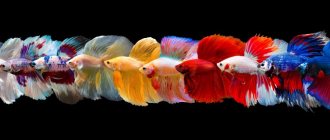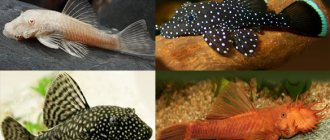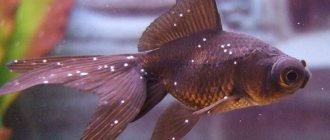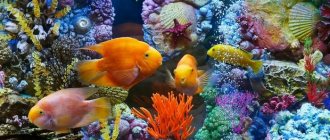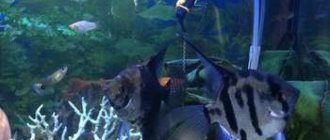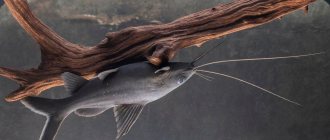Individuals live in fresh and salt water bodies. Macrognathus is rarely found in the wild and therefore can only be found in some water bodies in Thailand, India and Sri Lanka, where they prefer to stay in the shallow waters of long-flowing water bodies.
In behavior and shape they resemble the common eel: a small head and an elongated body. The fish is different in that its activity manifests itself at night. In captivity they live up to 10-15 years. This species can remain without water for some time (about 1 hour). Because of the spines on its back, the fish is called the “spiny eel.” In captivity, macrognathus live from 5 to 12 years.
Description of the fish
Most often it is light brown with spots of different colors. The body resembles a snake. The front part of the body is pointed and forms a kind of “proboscis”. The ridge on the back seems to divide the body in half. The anal and dorsal fins are similar to the tail. The pelvic fins are poorly developed or absent altogether.
The color is predominantly light brown, but most often depends on the environment in which the individual lives. With good care it can grow to large sizes. The belly of the fish is a different color, which is usually lighter than the main one.
Breeding rules
Although these fish reach fertility by 2-3 years, they do not reproduce under artificial conditions. Macrognathus spawning must be stimulated with specific injections.
The process is as follows: within a couple of days, the fish are seated, optimal conditions are provided and they are fed well. The spawning tank itself must be at least 1 m long and have a volume of at least 250 liters. The water temperature is adjusted to +26... +28 °C, its hardness should be average.
The spawning tank is equipped with a filter and aeration, shelter, substrate and mesh, and plants are placed. For one female, two males are usually planted, but you can also use just one pair of fish. The injection is given into the dorsal muscle, then the fish are stocked and the spawning ground is protected from light.
It will be useful for you to read about how to choose a filter, background stickers and soil for your aquarium.
The female lays about 1000 eggs, which fall through the net so that other fish do not eat them. Then everyone is seated
After 3 days, the fry emerge and begin to eat plankton, microworms and small cyclops.
Macrognathus has always attracted attention with its unusual, completely uncharacteristic appearance for fish. And his discreet behavior and ease of care make him an unpretentious and cute aquarium pet.
Maintenance and care
The aquarium must be covered , since macrognathus can crawl out into any crack. For an aquarium, a filter with moderate to strong water flow is recommended. Fish do not like bright sunlight, so you need to create shade by planting vegetation in the aquarium (or use moderate light that turns off at night). To create a familiar environment for fish, it is recommended to add 3-4 tablespoons of sea salt per 100 liters of water, but do not forget about other neighbors who may be harmed by salt. Macrognathus prefer clean, oxygenated water, so the aquarium must have a good aeration and filtration system.
Basic content rules:
- The aquarium must be covered with a lid, because fish can crawl out even into the smallest cracks.
- From time to time the water needs to be salted.
- The tank must have a good filtration and aeration system.
- Once a week it is necessary to change 25% of the water in the aquarium; The water needs to be completely changed every two weeks.
- The temperature level must be maintained all year round.
The physiology of macrognathus involves the frequent secretion of mucus, which needs to be gotten rid of. Excess mucus can lead to diseases, so to remove it, fish regularly bury themselves in the ground or rub against large stones. Sharp stones are inconvenient to burrow into and are dangerous: the gravel laid there must be checked for particles that could harm the fish. The soil layer should be at least 10-12 cm. Coarse washed sand is also good.
Decorations can include driftwood, decorations without sharp edges, and rounded stones. But it is recommended to lay them out in moderation so that the fish have room to swim. Plants must have developed root systems so that fish cannot tear them out by digging in the soil. If there are none, the plants need to be planted in the aquarium along with special pots to make them more stable. When planting plants, it is worth leaving empty spaces so that fish can burrow into them.
Diseases
Macrognathus are prone to skin diseases, as these inhabitants of the underwater world often burrow into the ground. If it turns out to be unsuitable or absent in the aquarium, then the mucus covering the body of the fish is not washed off, which leads to inflammation and the formation of ulcers.
Skin diseases are treated by gradually increasing the water temperature to 32 degrees and adding drugs such as ericycline. During the treatment period, the water in the aquarium is changed more often.
Eels living in aquariums are very rare. Caring for them is not the easiest task, and the reproduction of these fish causes many difficulties. Experienced breeders can overcome them. But the admiration of others for these unusual creatures more than pays for all the efforts made.
How do individuals reproduce?
By the beginning of spawning, the females hide, and the males begin to pursue them. Macrognathus does not reproduce well in captivity, so it is impossible to do without special hormonal injections that are given into the spinal muscle. Sometimes spontaneous spawnings occur without injections. After 11-14 hours the fish are ready to spawn. The pair selected for breeding is transplanted into a tank, where it is fed generously with a special high-protein diet. A female and two males can also be planted.
The spawning tank must be at least 20 liters and no shorter than a meter in length. You need to install a good filter and aeration system in your aquarium. The water hardness should be less than in the main aquarium - this will bring macrognathus closer to the natural habitat in which spawning occurs during the rainy season.
The water temperature in the spawning tank should be 26°C, a plastic mesh should be installed at the bottom, moss and small plants should be laid. Spawning lasts several hours. During this period, it is better not to disturb the fish.
The lethargy of the fish and their desire to burrow into the ground indicates the end of spawning, after which the individuals need to be transplanted into a regular aquarium. During spawning, about 1000 eggs are released, which sink to the bottom of the aquarium or attach to plants and the walls of the tank. The fry appear after 3-4 days. They feed on the yolk sac for several days and then begin feeding on their own. The basis of their diet should be brine shrimp and worms, as well as crushed dry food for adult fish. To maintain their health, the water temperature should not exceed 26-28°C.
It is necessary to regularly change the water and use drugs to destroy the fungus (to avoid disease in young fish). It is necessary to observe the growth of young fish and remove them, sorting them by size.
Reviews
The aquarium eel has captivated many. The varied behavior of pets is noteworthy. For some aquarists, the eel is mobile and accepts most types of food; for others, macrognathus hides in the ground and eats exclusively live food.
Feeding
Macrognathus are carnivorous fish, so they feed on small invertebrates, crustaceans, worms and insect larvae. They can hunt small fish. Individuals kept in aquariums most often feed on frozen natural food (bloodworms, brine shrimp), and some on finely chopped pieces of fish, squid and shrimp.
Constant consumption of dry food and flakes is not recommended (only as a vitamin supplement).
You need to feed the fish 3-4 times a week in the dark or with the lights off. Remove food that is not eaten after 3-5 minutes to prevent the aquarium from becoming dirty. The feeding process must be monitored to ensure that each individual gets food. Some fish can eat from your hands.
Macrognathus can change food preferences or refuse food completely.
Dry vitamin supplements are also recommended.
Adviсe
- Don't turn on the lights suddenly. First, turn on the dim light in the room, and after a few minutes, turn on the aquarium lamp.
- If the eel is outside the aquarium, place it in a container of water separately from other inhabitants. Do not disturb your pet for a while and monitor its condition.
- Frozen food should not be re-frozen.
- Place the aquarium away from sunlight to prevent excessive algae growth.
In addition to the ocellated fish, the Siamese macrognathus fish (Macrognathus siamensis) is popular. According to the description, macrognathus resemble mastacembelas, so they are often confused. Popular among the mastacembels are Moore's mastacembelus moorii, mastacembelus erythrotaenia, and mastacembelus armatus.
Previous
FishBasic components for feeding guppies
Next
FishWhat the corridor itself needs for a comfortable stay
Compatibility with other types
Macrognathus is not aggressive, but if there are small fish in the aquarium, it may begin to hunt them. It is better to purchase young fish in small schools (this will help them survive adaptation). It is better to keep adult individuals separately. It is not recommended to keep many individuals in one aquarium, because conflicts often arise between males over territory or during spawning. Sedentary fish are good:
- gourami;
- battles;
- parrotfish;
- mistuses;
- catfish.
Keeping cichlids with cichlids is strictly not recommended due to the mobility of this species, due to which macrognathus can mistake the cichlid for its prey and eat it.
It is recommended to place bottom species with macrognathus, which are peaceful, as well as large and active fish.
If you take Macrognathus with bare hands, you can injure yourself on its dorsal spines and cause an infection. This type of fish prefers a solitary settlement, but quickly adapts in a group.
General information
The ocellated astronotus (Astronotus ocellatus) is a large ray-finned fish from the Cichlid family. Also known as: tiger astronotus, Oscar cichlid, peacock eye, water buffalo.
The generic name comes from the two Greek words “astra” (ray) and “noton” (back), which refers to the shape of the dorsal and anal fins, the rays of which are directed towards the caudal fin. The specific epithet "ocellatus" is translated as "eye-shaped". This is a reference to the distinctive black spot located at the base of the tail, which resembles a large eye.
The fish appeared in amateur aquariums not so long ago. Astronotus came to Europe in 1934, and to our country only 20 years later.
Thanks to their unpretentiousness, beautiful coloring and high intelligence, the fish have become very popular among cichlid lovers. The only thing that limits the keeping of astronotuses is the need for large-volume aquariums and poor compatibility with other fish, because astronotuses are predators, ready to eat any fish that can fit in their mouth.
Aquarists who keep astronotuses note that the fish recognize the owner and very consciously observe everything that happens in the room. It is also not difficult to train the fish to take food from your hands; some individuals allow themselves to be stroked.
In the USA, astronotuses are an object of sport fishing, so special farms are created for their cultivation.
Astronotus is a very popular fish in Thailand, where it is raised in homes, workplaces and even in temples.
Breeders have obtained many color variations of this species, and even forms with a shortened body.
Varieties of Macrognathus
The species differ in external characteristics.
| View | Description |
| Macrognathus coffee | Dark brown color, pale spots on the back. Body length - 25 cm. It is more susceptible to fungal diseases than other species. |
| Macrognathus mother-of-pearl | Body length - 17 centimeters. Olive scales and brown spots on the sides. Light fins. |
| Macrognathus siamese | Body length - up to 35 cm. Color - olive-brown, with a “marble” pattern on the sides. |
| Zebra macrognathus | In an aquarium it can reach 40 centimeters in length. The body is flattened, covered with characteristic stripes. |
| Ocellated macrognathus | The color is beige or coffee. There are spots on the dorsal fin. Body length - 25 cm. |
Any type is suitable for keeping.
Macrognathus diseases and their treatment
The occurrence of pathologies is most often associated with poor living conditions and improper feeding. This type of fish is most susceptible to skin diseases. Excess mucus leads to the formation of ulcers. They are treated by increasing the water temperature (up to 32°C) and increasing salinity to 10%. Special anti-ulcer drugs are added to the water. Hexamitosis (affects the gallbladder and intestines) is also one of the common diseases. Her symptoms:
- Deterioration of appetite or loss of appetite.
- Mucous, thready excrement is white.
- Darkening of scales.
- Ulcers on the head.
- Swallowing and spitting out food, which is repeated regularly.
Other diseases:
| Name | Description |
| Poisoning | They may occur due to increased levels of chlorine and nitrogen compounds in the water or dirty soil. |
| Ichiophthiriasis | White pimples and inflammation appear on the skin. |
| Temperature shock | It occurs due to a sudden change in temperature, so it must be the same all the time. |
| Oodiniumosis | Excessive secretion of white-yellow mucus. The fish rubs against all surfaces in the aquarium. It is treated with special drugs. |
Diseases can only be cured at the initial stage, so fish need regular veterinary examinations. Therapy should be carried out by specialists. Having determined the cause of the pathology, they prescribe antibiotics. Hyperthermic water treatment can be used.
Macrognathus is a large and hardy fish that loves to swim. To create optimal living conditions for her, you need to work hard: change the water on time and do not neglect feeding; Make sure that the fish does not escape from the aquarium.
Breeding them is difficult, so only experienced aquarists should do this. If the fish is trained, it can eat directly from the owner's hands.
If the macrognathus does not like its living conditions, it can commit suicide by jumping out of the aquarium.
The fish is expensive and no less valuable.
Safety
The main causes of death of aquarium eels: hunger and skin diseases. But there are two more that are not obvious. First: they escape from the aquarium through the slightest crack. Forget open aquariums right away, they will simply run away and dry up somewhere in the dust.
But even a closed aquarium is unsafe! A tiny crack will be found and the eel will try to crawl through it. This is especially dangerous in aquariums with external filters, where there are holes for hoses. Another danger is treatment. Acne does not tolerate preparations containing copper well, and they are often used to treat the same semolina. In general, they do not tolerate treatment well, since they do not have small scales that poorly protect the body.

